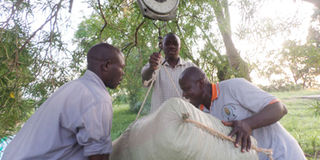Prime
How market information is vital for making decisions in agribusiness

Farmers in Bundibugyo District weigh a bag of cocoa. Having knowledge of the market situation helps in deciding whether to sell immediately or store the produce until the price is better. PHOTO BY BRIAN SSENOGA
Market information services (MIS) have significant benefits for farmers, traders, microfinance institutions (MFIs), non-governmental organisations (NGOs), donors and government, but it is clear that developing an efficient and sustainable MIS is far from easy. While the benefits appear, unarguably, the failure of many countries to operate reliable services so does the question of ability of agencies in promoting MIS in all circumstances.
Attention should be paid to capacity of the organisation and counterparts to operate a service, in terms of technical capacity and recurrent costs. Institutional arrangements need to be examined and the potential for private sector involvement should be investigated.
Basic steps can be taken to avoid some of the obvious problems. It is important to note that the greater the level of research at the beginning, the more likely is MIS to prove value to its target users. Secondly, tailoring the size and scope to available budgetary resources is likely to result in greater sustainability. Also, ensuring that staff are fully trained should result in more accurate MIS.
The importance of MIS cannot be underestimated.
Below are some of the reasons.
It can guide decision on where to sell: farm gate (home), village market (village), assembly market (trading centre), wholesale market (town) or individual consumers
It aids farmers to compare prices for better negotiations and where they stand with traders (prices broadcasts give a basis of negotiations), their agent in the wholesale market is getting them a good deal, quality of their produce is similar to that of other producers, etc.
It enables farmers/traders decide on whether or not to store: They can decide to store produce until prices go up.
It helps reduce risks associated with marketing. Farmers decide on when to send the produce to the market. Price of the produce may be lower than the costs involved in its production, therefore it may be cheaper to consume the food than sell it.
Historical data (price trends) reveals periods when prices of certain commodities are highest, average or lowest. It is important for decision on whether to grow or not to “grow out of season”. To use modern farming techniques (for instance, irrigation), a farmer can harvest crops when prices are the highest.
Information on various crops gives the farmer an opportunity to decide whether to grow different crops. The farmer can decide whether to grow different crops with higher prices but must consider cost of producing them (profitability) or a farmer may decide to continue with the same crops.
Market information can help in trade and market development. Apart from farmers receiving information on new production possibilities, it also informs the potential traders of trading opportunities. This can increase the number of outlets for the farmers and lead to greater competition among traders in the given area.
Market information is helpful for planning and evaluation. Such information assist government, NGOs, donors etc in planning. Identifying food security problems, that is, changes in prices can provide confirmation of localised food shortages. High prices somewhere may imply scarcity of those commodities there. Government and other stakeholders can use statistical data to evaluate the performance of a given commodity or the economy in terms of trade.
The importance of MIS is unarguably there, but the challenge is implementing a successful service as well as its sustainability.
It is important for organisations interested in establishing the service, to analyse needs in market information to come up with right strategies, develop the right products for the target groups and disseminate it in a way so as to reach these target groups.
Sharing of information allows for rapid improvements in the service by clients and better targeting of both information and resources. The linkage of the services has to be developed, which provides an opportunity to design a common, scalable data platform for the collection, storage, packaging and dissemination of data.
However, all agribusiness stakeholders should aim at promoting private sector initiatives in the MIS sector that will eventually attain equitable growth through inclusion of SMEs hence increasing competitiveness.
What is market information?
Market information services (MIS) can be defined in several ways and these include the following:
• Marketing information: This is information a user (farmer) needs to sell products in a given market at a good price, for example, buyers, prices, transporters, quality, among others.
• Production information: This is information on outputs (total volume of harvest) and required inputs (for example, machinery, seeds, fertilisers, credit) before products are bought to the market
• Agricultural market information=production information+ marketing information.
• Agricultural marketing information as a public good: This is the price information on products and services that clearly displays and states for the user an indicative price to make a decision whether or not to buy a good or service or to compare prices of two products and services
• Agricultural market information as a private good: This is repackaged to give detailed analysis according to the needs, benefits, habits and expectations of the user thus adding value to the MIS as a trade commodity
• Both marketing and production are functions of business and directly relate to profitability of an enterprise
The writer is a senior consultant, FIT Uganda Ltd




